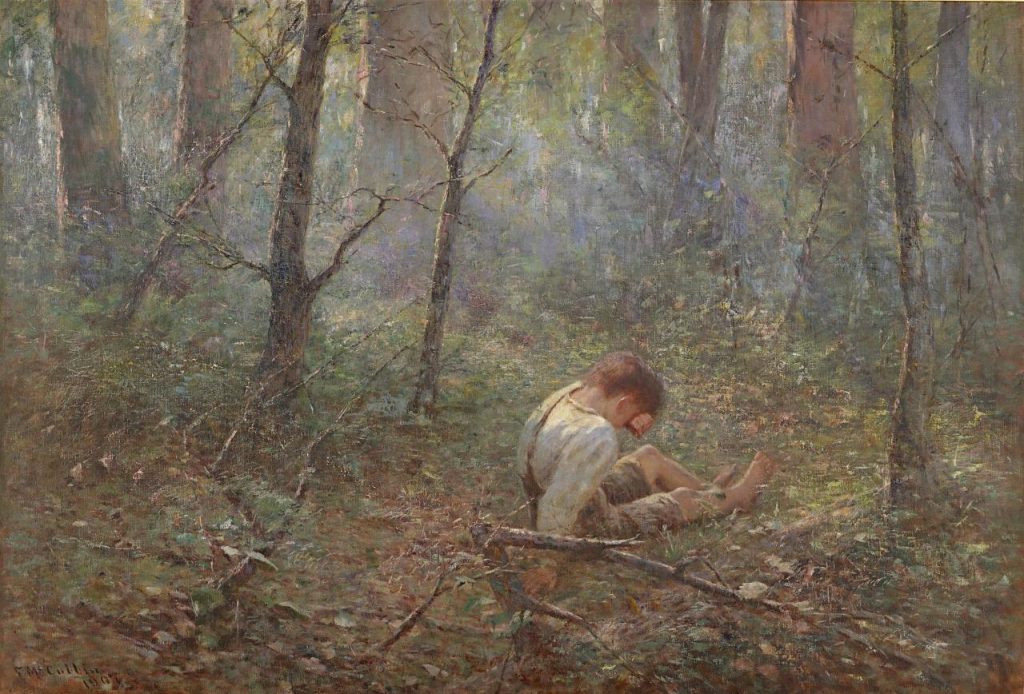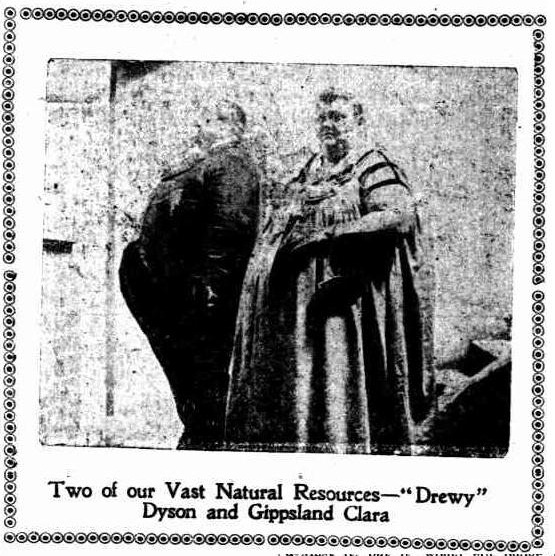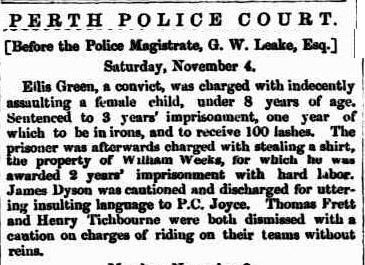He was a monster. That has to be made plain from the start. He could be very funny, he was creative and he was intelligent. He loved animals. He probably loved his family, but he also hurt them. He hurt them a lot. He also hurt many of the animals he loved as well, and he also hurt himself. He could laugh at himself. Others laughed at him too, a lot. He would have been fun to know personally but he humiliated those who had no choice but to share his name. He was the meanest drunk Western Australia has possibly ever known (and I realise that is a bold claim to make) and he was the fattest Western Australian of the nineteenth century. He was Andrew “Drewy” Dyson.
He was born in Perth on 30 October 1858. His father was the colonial entrepreneur James Dyson. His mother was Mrs Jane Edwards. There were still a few more years to go before Jane’s first husband could be declared legally dead and the two could finally marry, so rather than face any needless embarrassment— as with the previous two children they had already had together— Andrew Dyson’s birth was not formally registered.
The colony that Andrew was born into was not the same place his parents had arrived into, eight and seventeen years before, respectively. It was a far more dangerous place, for one. Half the population was under legal curfew at night, the other half huddled behind locked or bolted doors in a de-facto state of curfew in terror of any curfew-breakers from the other half. Western Australia was now a Convict settlement, and a rough and rowdy place to live in and bring up children. On a positive note, those same convicts had made Andrew Dyson’s father quite rich, and soon he might completely paper over his own chequered past with a thin veneer of promissory notes.
Labour shortages back when James Dyson arrived in 1841 had enabled him to fill a niche as a timber cutter and he must have had at least one other confederate to assist him in that enterprise. (Pit sawing requires at least two people) But that same shortage of labour must have at the same time limited how much Dyson could grow his business, which now included contracts for wood used to construct public buildings. That all changed with the arrival of the convicts in 1850. Usually paroled as soon as they stepped ashore, these men were available for hire almost straight away, and Dyson was soon one of the biggest employers of labour in the colony. So when someone was referred to as working for James Dyson, odds-on that person would be a ticket-of-leave convict.
Young Andrew Dyson first burst in to public prominence when he was nine in October 1867. He was travelling with a party of his father’s men deep into the Canning district south and east of Perth. They followed the rough dirt track that was then the Albany road to a location some way past what is now known as Armadale. It was there that the carter had some unspecified work to do about 100 metres away from the track. For some further unspecified reason Andrew tagged along with him accompanied only by his dog. The carter sent Drewy back to wait by the cart, or so it was reported, however the boy never reached that destination.

It is one of the greatest tropes of Australian culture — the child lost in the bush. For parents who came from a very different landscape in the northern hemisphere where the deep dark forest was a fairytale nightmare from the distant past, here it was for real. It scared the living shit out of them, being in it. Even more gut wrenching was the thought of their children out in it, alone and helpless, and there was nothing they could do. People would rather have thought the mother done it than a “dingo took my baby”…
The news would have shuddered through the populace — everyone would have known. Children died of diseases like dysentery every day. That was sad, but it did not make it into the paper. A child lost in the bush did.
Dyson rode out to join in the search personally. His mind must have jumped back to all the children he had lost: His first daughter Hannah, aged only seven months; his eldest son George in a cart accident aged 16; Samuel, barely a year old from whooping cough two years before. Then just a few months ago, there was that regrettable affair with Thomas, his second eldest child with Jane. Thomas was thirteen, but he had disgraced himself so he had been sent far away to Melbourne to serve an apprenticeship there; it must have felt like he had died too.
James Dyson reached Narrogin on the Albany road on the 8 October 1867. It was not the town of that name about 150km from Perth along the route, but the other settlement called Narrogin that was only about 50km from home on the Albany road. If you are confused you were not alone. Some of the papers mixed them up too. This might be why the closer of the two to Perth changed their name to Armadale. The Narrogin Inn that Dyson would have passed through is still there, but not in any form that he would recognise.
Dyson, that day, carried with him the hopes and best wishes of all his peers, hoping for the best, but expecting the worse. Dyson skated on thin ice sometimes in regards to authority, but no-one could doubt he loved his children. Right now, right then, everyone was on his side, everyone was riding with him that day. Andrew had been missing now for six days.
As anyone knows who have taken the Albany Highway from Perth to Albany even today, the road twists and rises past Armadale, climbing into the Darling scarp. Even today, tall dense timber hugs the sides of the road, you would think, wandering in there, you would never come out again. But some distance past the Narrogin Inn, that was where Dyson encountered a man on a horse with a young boy and his dog. Andrew had been found, safe and sound. The paper tells the story:
LOST IN THE BUSH.— An unfortunate case of being lost in the bush occurred last week. A lad of about nine years of age, the son of Mr. J. Dyson, of Perth, accompanied a carter with a team of his father’s to the Canning, and when about 26 miles from Perth, the carter occupied himself in some work off the road, and sent the boy back to the cart, some 150 yards distant. He lost his way while attempting to reach it ; and was unable, from the nature of the country, to recover himself. In his rambles he discovered a horse track, which he followed some miles, but night closed on him, and he lay down in the hollow of a tree till morning with his dog, which had faithfully kept by him the whole time. On waking in the morning, he continued on the track he abandoned the night before, which soon led him to the house of a man named Hesketh, who conducted him over to the residence of Mr. T. Buckingham, whose kindness and hospitality are highly commendable. Mr. Buckingham, as soon as possible, sent the child on the road towards Perth, in charge of one of his servants, who were met near Narrogin by the child’s father, by whom he was brought to his home.
The Inquirer & Commercial News, Wednesday 9 October 1867 p2
For James, from this moment, everything started going right in his life, and his good fortune continued for the most extended period he would ever experience. The previous year he missed out on a spot in the Perth City Council by only a few votes. That December he was finally elected as a Councillor for the West Ward, a position he would hold continuously for eight years. Once again, I have no hard evidence for this; but I believe the good will for his son’s safe recovery might have pushed him over the line.
Drewy was not named in his first media appearance, but there is not doubt that it was he. But one question remained unanswered; did his father hug him, or did he get a cuff around the ear? This was Drewy’s first mention in the papers, but it would be far from being his last, and the next time around his family would be wishing they would keep his name out of print.
Further research
Who was Hesketh (who “rescued” Drewy)? He was not Joseph Hesketh, the former convict, who was already dead…
Did Drewy encounter “Moondyne” Joe Johns on the lam?




